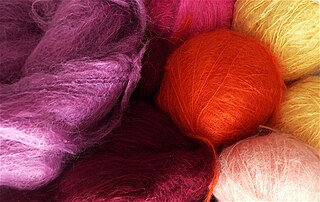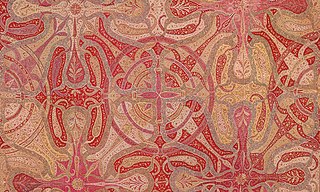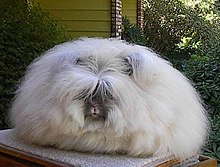
Wool is the textile fiber obtained from sheep and other mammals, especially goats, rabbits, and camelids. The term may also refer to inorganic materials, such as mineral wool and glass wool, that have some properties similar to animal wool.

Yarn is a long continuous length of interlocked fibres, used in sewing, crocheting, knitting, weaving, embroidery, ropemaking, and the production of textiles. Thread is a type of yarn intended for sewing by hand or machine. Modern manufactured sewing threads may be finished with wax or other lubricants to withstand the stresses involved in sewing. Embroidery threads are yarns specifically designed for needlework. Yarn can be made of a number of natural or synthetic materials, and comes in a variety of colors and thicknesses. Although yarn may be dyed different colours, most yarns are solid coloured with a uniform hue.

The Angora or Ankara is a Turkish breed of domesticated goat. It produces the lustrous fibre known as mohair. It is widespread in many countries of the world. Many breeds derive from it, among them the Indian Mohair, the Soviet Mohair, the Angora-Don of the Russian Federation and the Pygora in the United States.

Mohair originated from the Arabic word [مهير] and it is a fabric or yarn made from the hair of the Angora goat. Both durable and resilient, mohair is lustrous with high sheen, and is often blended to add these qualities to a textile. Mohair takes dye exceptionally well. It feels warm in winter due to excellent insulating properties, while moisture-wicking keeps it cool in summer. It is durable, naturally elastic, flame-resistant and crease-resistant. It is considered a luxury fiber, like cashmere, alpaca, angora, and silk, but is more expensive than most sheep's wool.

The Angora rabbit, one of the most ancient groups of domestic rabbit breeds, which is bred for the long fibers of its coat, known as Angora wool. They are gathered by shearing, combing or plucking. Because rabbits do not possess the same allergy-causing qualities as many other animals, their wool is an important alternative. There are at least 11 distinct breeds of Angora rabbit, four of which are currently recognized by the American Rabbit Breeders Association (ARBA): the English Angora, the French Angora, the Giant Angora and the Satin Angora. Other unrecognized breeds include the German Angora, the Finnish Angora, the Chinese Angora, the Japanese Angora, the Korean Angora, the Russian Angora, the St Lucian Angora and the Swiss Angora.

Cashmere wool, usually simply known as cashmere, is a fiber obtained from cashmere goats, pashmina goats, and some other breeds of goat. It has been used to make yarn, textiles and clothing for hundreds of years. Cashmere is closely associated with the Kashmir shawl, the word "cashmere" deriving from an anglicization of Kashmir, when the Kashmir shawl reached Europe in the 19th century. Both the soft undercoat and the guard hairs may be used; the softer hair is reserved for textiles, while the coarse guard hair is used for brushes and other non-apparel purposes. Cashmere is a hygroscopic fiber, absorbing and releasing water from the air based on the surrounding environment. This helps regulate the body in both warm and cool temperatures.
Wool is the textile fibre obtained from sheep.

Pashmina refers to, depending on the source, the cashmere wool of the Changthangi cashmere goat, fine Kashmiri cashmere wool, or any cashmere wool.

Qiviuq [sg] or qiviut [pl] is the inner wool of the muskox. In Inuinnaqtun the same word can be used to refer any down such as the down feathers of birds.

Haircloth is commonly understood as a stiff, unsupple fabric made from coarse fibre from camelids, bovines, horses, goats, rabbits, hares and reindeers. However, a softer variation is valued in the textile and fashion industries for their rarity, aesthetics and comfort. This is because there are two types of hair used in making haircloth; a rougher outer “guard coat”, and a softer undercoat. The outer coats are used in coarse fabrics, often applied to upholstery, carpets, underskirts and hairshirts, or cilices, while "luxury fabrics" use the softer undercoat.

Camel hair specifically refers to the fur from the body of a camel, but more generally refers to the fibre that may be made from either pure camel hair or a blend of camel hair and another fibre.

The Pygora goat is a breed of goat that originated from crossing the registered NPGA Pygmy goat and the white AAGBA Angora goat. Pygoras, along with the Angora goat and Cashmere goat, are fiber goats. Pygora goats produce three distinct kinds of fleece.

The Orenburg shawl is a Russian knitted lace textile using goat down and stands as one of the classic symbols of Russian handicraft, along with Tula samovars, the Matrioshka doll, Khokhloma painting, Gzhel ceramics, the Palekh miniature, Vologda lace, Dymkovo toys, Rostov finift (enamel), and Ural malachite.

The Nigora is an American breed of small or medium-sized dual-purpose goat, raised both for its milk and for its fiber. It is the result of cross-breeding Nigerian Dwarf bucks with does of mohair breeds such as the Angora.
The manufacture of textiles is one of the oldest of human technologies. To make textiles, the first requirement is a source of fiber from which a yarn can be made, primarily by spinning. The yarn is processed by knitting or weaving, with color and patterns, which turns it into cloth. The machine used for weaving is the loom. For decoration, the process of coloring yarn or the finished material is dyeing. For more information of the various steps, see textile manufacturing.
The United Nations General Assembly declared 2009 as the International Year of Natural Fibres (IYNF), as well as the International Year of Astronomy.

Animal fibers are natural fibers that consist largely of certain proteins. Examples include silk, hair/fur and feathers. The animal fibers used most commonly both in the manufacturing world as well as by the hand spinners are wool from domestic sheep and silk. Also very popular are alpaca fiber and mohair from Angora goats. Unusual fibers such as Angora wool from rabbits and Chiengora from dogs also exist, but are rarely used for mass production.
Chiengora, also called "dog wool," is yarn or wool spun from dog hair. The word is a portmanteau of chien and angora and was coined by an American spinner, Annette Klick. Dog hair is up to 80% warmer than wool and is not elastic.

Alpaca fleece is the natural fiber harvested from an alpaca. There are two different types of alpaca fleece. The most common fleece type comes from a Huacaya. Huacaya fiber grows and looks similar to sheep wool in that the animal looks "fluffy". The second type of alpaca is Suri and makes up less than 10% of the South American alpaca population. Suri fiber is more similar to natural silk and hangs off the body in locks that have a dreadlock appearance. While both fibers can be used in the worsted milling process using light weight yarn or thread, Huacaya fiber can also be used in a woolen process and spun into various weight yarns. It is a soft, durable, luxurious and silky natural fiber.
Textile manufacturing is one of the oldest human activities. The oldest known textiles date back to about 5000 B.C. In order to make textiles, the first requirement is a source of fibre from which a yarn can be made, primarily by spinning. The yarn is processed by knitting or weaving to create cloth. The machine used for weaving is the loom. Cloth is finished by what are described as wet process to become fabric. The fabric may be dyed, printed or decorated by embroidering with coloured yarns.
















